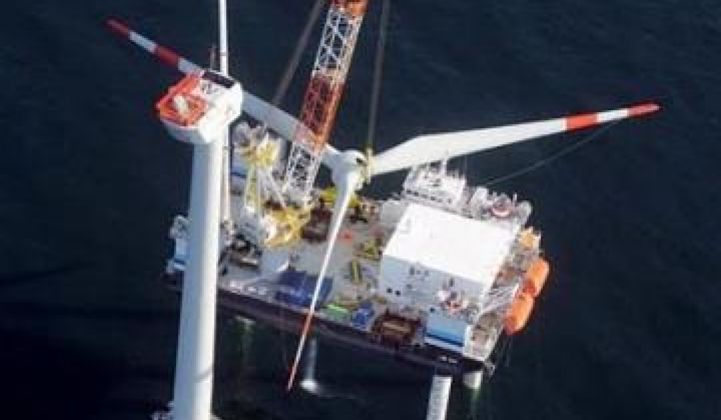U.S. wind builders are on the verge of developing the enormous wind assets off the Atlantic Coast and on the Great Lakes. A recent Oceana study suggested the Eastern Seaboard alone could see 127 gigawatts of wind capacity installed by 2030. That’s something like 25,000 huge wind turbines to be installed, serviced and maintained. New transmission will also be needed.
The Oceana study foresaw 133,000 to 212,000 new jobs from the undertaking, many from expansion by established turbine manufacturers and suppliers. But there are no U.S. builders of the huge seagoing vessels that will be needed to erect and maintain those turbines. The lack of U.S.-made vessels could present a significant obstacle to offshore wind’s growth because the Jones Act, obscure legislation enacted to protect U.S. shipbuilders, prevents vessels made elsewhere from servicing domestic ports.
The American Bureau of Shipping (ABS) has been developing and verifying standards for marine-related vessels and facilities since 1862. Recent adaptation of offshore oil and gas industry construction vessels (OCVs) for work with wind projects prompted ABS this year to establish a new chapter in its manual and officially designate a Wind IMR unit dedicated to offshore wind turbine installation, maintenance and repair.
Rasmus Stute, Head of the Offshore Service Vessels Department for world-renowned German industry consultant Germanischer Lloyd (GL), said European offshore wind development experience at depths to 50 meters shows that such Wind IMRs should have unique capacities.
They must be self-propelled so as to navigate between the shore and the installation. They must be jack-up vessels, capable of dropping legs to the ocean floor and raising their platforms ten to fifteen meters above the waves. Typically 160 meters long and 50 meters wide, they must have enough deck space to carry foundations of 900 to 1000 tons and enough power to pile-drive them into the seabed.
The vessels must also carry 90-meter long, 100-to-200-ton towers and cranes capable of setting such towers on the foundations. The cranes must be equally capable of lifting 400-to-500-ton nacelles 110 meters in the air and positioning them atop the towers. The vessels must also have deck space for preparatory work with offshore turbines’ huge components, as well as carrying capacity for construction crews, support personnel and vessel crews.
Finally, the vessels must have dynamic positioning capability so as to both hold themselves in place while the work is being done and move themselves, when necessary, a precise meter or two to facilitate construction even as waves and winds roil.
Such vessels, Stute said, cost between US$150 million to $220 million and take about two years to build.
This could herald a renewable energy sector business opportunity and, ironically, it might initially involve, according to Jim Lanard, President of the Offshore Wind Development Coalition, converted oil and gas industry vessels. Lanard said there is plenty of unused capacity in the Gulf of Mexico ready to be retrofitted.
“There are a lot of companies out there that have been watching developments,” Mike Sano, a Senior Engineer in Corporate Energy Project Development with ABS, said. “But there are none that I know of that have committed to building an offshore wind installation vessel for the U.S. market.” ABS has, however, recently classed UK-based Seajacks International’s Seajacks Kracken and Seajacks Leviathan, self-propelled jack-up vessels intended for service both in Europe’s offshore wind and offshore oil and gas industries.
Adapting techniques and equipment from offshore oil and gas work for building offshore wind is being pioneered in Scotland. Both Scotland’s study of North Sea oil exploration and development know-how and its adaptation of oil rig platform designs was described by Michael Kanellos in this space last year.
GL’s Stute said using retrofitted oil and gas industry vessels will work with prototype and smaller projects in the earliest stage of U.S. offshore development but “for building a large scale wind farm to a very tight time schedule” he is dubious. “We have tried to use one of these units in Europe,” he said. “When it came to the actual installation work, these vessels showed a relatively poor performance compared to the purpose-built units.”
Stute has no doubt oil industry vessels “will find their niche,” he added, perhaps in maintenance. But retrofitted vessels, he explained, cannot have the full range of capabilities needed for this application. “The combination of deck area, accommodation area, maneuvering, sailing capacity and lifting of weights to heights,” he enumerated. “All of them at the same time might be difficult.”
The best offshore wind IMRs, Stute said, are being built by Korea’s Daewoo Shipbuilding and Marine Engineering and Samsung Heavy Industries, by Poland’s Crist Shipyard and by Germany’s Sietas Shipyard. This means that the Jones Act could -- if it stands -- make it impossible for U.S. offshore wind developers to access the best vessels unless they undertake the extra financial burden of establishing domestic shipbuilding capacity.
This further complicates a renewable energy policy landscape U.S. wind developers now face that may be even more difficult to endure than the harsh offshore ocean environment.
“When you try to persuade your bank to give you $150 million to $220 million U.S. dollars, you need to come up with a business plan and a business model that works over 10 years to 20 years,” Stute said. “You do not touch such huge projects if your tax credits work only for two years. You can only do this if you have a long-term commitment.”



